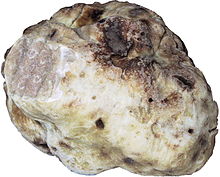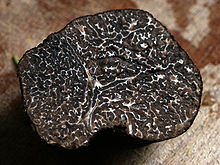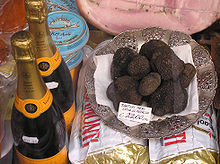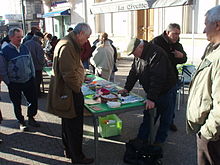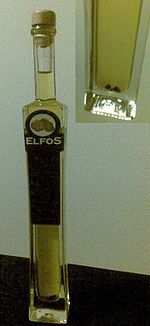- Truffle (fungus)
-
A truffle (
 /ˈtrʌfəl/) is the fruiting body of an underground mushroom; spore dispersal is accomplished through fungivores, animals that eat fungi. Almost all truffles are ectomycorrhizal and are therefore usually found in close association with trees.
/ˈtrʌfəl/) is the fruiting body of an underground mushroom; spore dispersal is accomplished through fungivores, animals that eat fungi. Almost all truffles are ectomycorrhizal and are therefore usually found in close association with trees.There are hundreds of species of truffles, but the fruiting body of some (mostly in the genus Tuber) are highly prized as a food. The 18th-century French gastronome Brillat-Savarin called these truffles "the diamond of the kitchen". Edible truffles are held in high esteem in French, Spanish, northern Italian and Greek cooking, as well as in international haute cuisine.
Contents
Etymology
The origin of the word truffle appears to be the Latin term tuber, meaning "swelling" or "lump", which became tufer- and gave rise to the various European terms: French truffe, Spanish trufa, Danish Trøffel, German Trüffel, Swedish tryffel, Dutch truffel, Polish trufel and Croatian tartuf. In Portuguese, the words trufa and túbera are synonyms, the latter closer to the Latin term. The German word Kartoffel ("potato") is derived from the Italian tartufo (truffle) because of superficial similarities.[1]
Biology
The mycelia of truffles form symbiotic relationships with the roots of several tree species including beech, poplar, oak, birch, hornbeam, hazel, and pine.[2][3] They prefer argillaceous or calcareous soils which are well drained and neutral or alkaline.[4][5] Truffles fruit throughout the year, depending on the species and can be found buried between the leaf litter and the soil.
Types
White truffle
The "white truffle" or "Alba madonna" (Tuber magnatum) comes from the Langhe and Montferrat areas[6] of the Piedmont region in northern Italy and, most famously, in the countryside around the cities of Alba and Asti[7]; in Italy it can also be found in Molise and in the hills around San Miniato, in Tuscany. It is also found in Croatia, on the Istria peninsula in the Motovun forest alongside Mirna river.[8] Growing symbiotically with oak, hazel, poplar and beech and fruiting in autumn, they can reach 12cm diameter and 500 g, though are usually much smaller. The flesh is pale cream or brown with white marbling.[9] Italian white truffles are very highly esteemed (illustration, left) and are the most valuable on the market: the white truffle market in Alba is busiest in the months of October and November when the Fiera del Tartufo (truffle fair) takes place. In 2001, the Tuber magnatum truffles sold for between US$1,000 and $2,200 per pound (US$2000 to US$4500 per kg);[10] as of December 2009 they were being sold at €10,200 per kilogram.[11]
Giancarlo Zigante and his dog Diana found one of the largest truffles in the world near Buje, Croatia. The truffle weighed 1.31 kilograms (2 lb 14 oz) and has entered the Guinness Book of Records.[12]
The record price paid for a single white truffle was set in December 2007, when Macau casino owner Stanley Ho paid US$330,000 (£165,000) for a specimen weighing 1.5 kilograms (3.3 lb), discovered by Luciano Savini and his dog Rocco. One of the largest truffles found in decades, it was unearthed near Pisa and sold at an auction held simultaneously in Macau, Hong Kong and Florence.[13] This record was then matched on November 27, 2010 when Ho again paid US$330,000 for a pair of white truffles including one weighing nearly a kilogram.
The Tuber magnatum pico white truffle is found mostly in northern and central Italy, while the Tuber borchii, or whitish truffle, is found in Tuscany, Romagna, the Marche and Molise. Neither of these is as aromatic as those from Piedmont, although those from Città di Castello come quite close.[9]
Black truffle
The "black truffle" or "black Périgord truffle" (Tuber melanosporum) is named after the Périgord region in France and grows with oak and hazelnut trees. Specimens can be found in late autumn and winter, reaching 7 cm in diameter and weighing up to 100 g.[9] Production is almost exclusively European, with France accounting for 45%, Spain 35%, Italy 20%, and small amounts from Slovenia, Croatia and the Australian states of Tasmania and Western Australia (see below). In 1900, France produced around 1,000 metric tonnes (1,100 short tons) of Tuber melanosporum. Production has considerably diminished in the past century, and is now around 20 metric tonnes (22 short tons) per year, with peaks at 46 metric tonnes (50 short tons) in the best years. About 80% of the French production comes from southeast France: upper Provence (départements of Vaucluse and Alpes-de-Haute-Provence), part of Dauphiné (département of Drôme), and part of Languedoc (département of Gard); 20% of the production comes from southwest France: Quercy (département of Lot) and Périgord. The largest truffle market in France (and probably also in the world) is at Richerenches in Vaucluse. The largest truffle market in southwest France is at Lalbenque in Quercy. These markets are busiest in the month of January, when the black truffles have their highest perfume. As of December 2009, black truffles were sold for about €1,000 per kilo in a farmer's market[14] and €3,940 per kilo in a retail saler.[15] The genome sequence of the Périgord black truffle was published in March 2010.[16]
Chinese truffles
The "Chinese truffle" (Tuber sinensis, also sometimes called Tuber indicum) is a winter black truffle harvested in China. Due to their bountiful growth, Chinese truffles are often exported to the West as an inferior-quality substitute of Tuber melanosporum. Some truffle exporters or delicatessen shops sell Chinese truffles into which extracts of the real Tuber melanosporum are introduced. These truffles are often sold at a high price, marked as Tuber melanosporum.[17] Another type of Chinese truffle is the Tuber himalayensis, which looks so much like the Tuber melanosporum that a microscope is needed to differentiate them. The Tuber himalayensis is harvested in very small quantities in the Chinese Himalayas due to the high altitude, and is not as frequently met on world markets as the Tuber sinensis. The third type of Chinese truffle is the Chinese summer white truffle, which does not yet have a scientific name.[citation needed]
Summer or burgundy truffle
Main article: Summer truffleThe black summer or burgundy truffle (Tuber aestivum/uncinatum) is found across Europe and is prized for its culinary value. Two varieties are distinguished within this species: burgundy truffles, harvested in autumn until December, and summer truffles, harvested in summer, whose flesh is of paler color and whose aroma is less pronounced.
Other species
Two lesser-used truffles include the "black truffle" (Tuber macrosporum) and the "Scorzone truffle" (Tuber aestivum).
In the US Pacific Northwest, several species of truffle are harvested both recreationally and commercially, most notably, the "Oregon white truffles", Tuber oregonense and Tuber gibbosum.
The "pecan truffle" (Tuber lyonii[18] syn. texense[19]) is found in the Southern United States, usually associated with pecan trees. Chefs who have experimented with them agree "they are very good and have potential as a food commodity".[20] Although pecan farmers used to find them along with pecans and discard them, considering them a nuisance, they sell for about $100 a pound and have been used in some gourmet restaurants.
Truffle-like species
The term "truffle" has been applied to several other genera of similar underground fungi. The genera Terfezia and Tirmania of the family Terfeziaceae are known as the "desert truffles" of Africa and the Middle East. "Hart's truffle" is a name for Elaphomycetaceae. Pisolithus tinctorius, which was historically eaten in parts of Germany, is sometimes called "Bohemian truffle".[21]
History
Antiquity
The first mention of truffles appears in the inscriptions of the neo-Sumerians regarding their Amorite enemy's eating habits (Third Dynasty of Ur, 20th century[22]) and later in writings of Theophrastus in the fourth century BC. In classical times, their origins were a mystery that challenged many; Plutarch and others thought them to be the result of lightning, warmth and water in the soil, while Juvenal thought thunder and rain to be instrumental in their origin. Cicero deemed them children of the earth, while Dioscorides thought they were tuberous roots.[21]
Italy in the Classical period produced three kinds of truffles: the Tuber melanosporum, the Tuber magnificanus and the Tuber magnatum. The Romans, however, only used the terfez (Terfezia bouderi), a fungus of similar appearance, which the Romans called truffles, and which is sometimes called "desert truffle". Terfez used in Rome came from Lesbos, Carthage, and especially Libya, where the coastal climate was less dry in ancient times.[21] Their substance is pale, tinged with rose. Unlike truffles, terfez have no taste of their own. The Romans used the terfez as a carrier of flavour, because the terfez have the property to absorb surrounding flavours. Indeed, Ancient Roman cuisine used many spices and flavours, and terfez were perfect in that context.
Middle Ages
Truffles were rarely used during the Middle Ages. Truffle hunting is mentioned by Bartolomeo Platina, the papal historian, in 1481, when he recorded that the sows of Notza were without equal in hunting truffles, however they should be muzzled to prevent them from eating the prize.[23]
Renaissance and modern times
During the Renaissance, truffles regained popularity in Europe and were honoured at the court of King Francis I of France. However, it was not until the 17th century that Western (and in particular French) cuisine abandoned "heavy" oriental spices, and rediscovered the natural flavour of foodstuffs. Truffles were very popular in Parisian markets in the 1780s. They were imported seasonally from truffle grounds, where peasants had long enjoyed their secret. Brillat-Savarin (1825) noted characteristically that they were so expensive they appeared only at the dinner tables of great nobles and kept women. A great delicacy was a truffled turkey.
Cultivation
Truffles long eluded techniques of domestication, as Jean-Anthelme Brillat-Savarin (1825) noted with his characteristic skepticism:
Mushroom and truffle output in 2005
"The most learned men have sought to ascertain the secret, and fancied they discovered the seed. Their promises, however, were vain, and no planting was ever followed by a harvest. This perhaps is all right, for as one of the great values of truffles is their dearness, perhaps they would be less highly esteemed if they were cheaper."
However, truffles can be cultivated. As early as 1808, there were successful attempts to cultivate truffles, known in French as trufficulture. People had long observed that truffles were growing among the roots of certain trees, and in 1808, Joseph Talon, from Apt (département of Vaucluse) in southern France, had the idea to sow some acorns collected at the foot of oak trees known to host truffles in their root system.
The experiment was successful: years later, truffles were found in the soil around the newly grown oak trees. In 1847, Auguste Rousseau of Carpentras (in Vaucluse) planted 7 hectares (17 acres) of oak trees (again from acorns found on the soil around truffle-producing oak trees), and he subsequently obtained large harvests of truffles. He received a prize at the 1855 World's Fair in Paris.
These successful attempts were met with enthusiasm in southern France, which possessed the sweet limestone soils and dry hot weather that truffles need to grow. In the late 19th century, an epidemic of phylloxera destroyed many of the vineyards in southern France. Another epidemic destroyed most of the silkworms in there, too, making the fields of mulberry trees useless. Thus, large tracts of land were set free for the cultivation of truffles. Thousands of truffle-producing trees were planted, and production reached peaks of hundreds of tonnes at the end of the 19th century. In 1890, there were 750 square kilometres (190,000 acres) of truffle-producing trees.
In the 20th century, however, with the growing industrialization of France and the subsequent rural exodus, many of these truffle fields (champs truffiers or truffières) returned to wilderness. The First World War also dealt a serious blow to the French countryside, killing 20% or more of the male working force. As a consequence of these events, newly acquired techniques of trufficulture were lost. Also, between the two world wars, the truffle fields planted in the 19th century stopped being productive. (The average life cycle of a truffle-producing tree is 30 years.) Consequently, after 1945, the production of truffles plummeted, and the prices have risen dramatically. In 1900, truffles were used by most people, and on many occasions. Today, they are a rare delicacy reserved for the rich, or used on very special occasions.
In the last 30 years, new attempts for mass production of truffles have been started. Eighty percent of the truffles now produced in France come from specially planted truffle fields. Nonetheless, production has yet to recover its 1900s peaks. Local farmers are opposed to a return of mass production, which would decrease the price of truffles. There are now truffle-growing areas in the United States, Spain, Sweden, New Zealand, Australia, Chile and the UK.
In New Zealand and Australia
The first black truffles (Tuber melanosporum) to be produced in the southern hemisphere were harvested in Gisborne, New Zealand in 1993.[citation needed]
In 1999, the first Australian truffles were harvested in Tasmania,[citation needed] the result of eight years of work. Trees were inoculated with the truffle fungus in the hope of creating a local truffle industry. Their success and the value of the resulting truffles has encouraged a small industry to develop. A Western Australian venture, The Wine and Truffle Co, had its first harvest in 2004, and in 2005 they unearthed a 1 kg truffle. In 2008, an estimated 600 kilograms (1,300 lb) of truffles were removed from the rich ground of Manjimup. Each year The Wine and Truffle Co. has expanded its production, moving into the colder regions of Victoria and New South Wales.
In June 2010, Tasmanian growers Michael and Gwynneth Williams harvested Australia's largest truffle from their property at Myrtle Bank, near Launceston. It weighed in at 1.084 kilograms (2 lb 6.2 oz).[24] Ms Williams told ABC Radio in Australia[25] that it is valued at approximately AUS$1,500 per kilo.
Extraction
Looking for truffles in open ground is almost always carried out with specially trained pigs (truffle hogs) or, more recently, dogs. The Lagotto Romagnolo is currently the only breed recognized for sniffing out truffles (although virtually any breed could be trained for this use).[26]
Truffle Hog Truffle Dog Keen sense of smell Keen sense of smell Innate ability to sniff out truffles Must be trained Tendency to eat truffles once found Easier to control The female pig's natural truffle seeking, as well as her usual intent to eat the truffle, is due to a compound within the truffle similar to androstenol, the sex pheromone of boar saliva, to which the sow is keenly attracted.
Culinary use
Because of their high price and their pungent taste, truffles are used sparingly. Supplies can be found commercially as unadulterated fresh produce or preserved, typically in a light brine.
White truffles are generally served raw, and shaved over steaming buttered pasta or salads or fried eggs (the latter is recommended by many gourmets as the best way to enjoy the flavour). White or black paper-thin truffle slices may be inserted into meats, under the skins of roasted fowl, in foie gras preparations, in pâtés, or in stuffings. Some speciality cheeses contain truffles as well.
The flavour of black truffles is far less pungent and more refined than that of white truffles. Its strong umami (Japanese meaning "pleasant savory taste") flavor is reminiscent of fresh earth and dashi, and when fresh, their scent fills a room almost instantly.
While in the past chefs used to peel truffles, in modern times most restaurants brush the truffle carefully and shave it or dice it with the skin on so as to use most of this expensive ingredient. A few restaurants, such as Philippe Rochat in Switzerland, still stamp out circular discs of truffle flesh and use the skins for sauces.
Truffle oil
Main article: Truffle oilTruffle oil is often used as a lower cost and convenient substitute for truffles, to provide flavouring or to enhance the flavour and aroma of truffles in cooking. Most "truffle oil," however, does not contain any truffles.[27] The vast majority is olive oil which has been artificially flavoured using a synthetic agent such as 2,4-dithiapentane.[27] Daniel Patterson reported in the New York Times that "even now, you will find chefs who are surprised to hear that truffle oil does not actually come from real truffles."
Truffle vodka
Main article: Truffle vodkaThe bulk of truffle oil on the market is made with a synthetic ingredient like 2,4-dithiapentane, as are many other truffle products. However, alcohol is now being used to carry the truffle flavour without the need for synthetic flavourings. The first truffle vodka, Black Moth Vodka, is a natural vodka infused with black Périgord truffles (Tuber melanosporum). Although primarily used as a spirit in its own right and mixed in a range of cocktails, truffle vodka is also used by various chefs to flavour dishes by evaporating the alcohol through cooking whilst retaining the truffle aroma.[28]
Notes
- ^ Simpson J, Weiner E.(eds) (1989) Oxford English Dictionary, 2nd edition, Clarendon Press, ISBN 0-19-861186-2
- ^ "‘finds’ registered at Royal Botannical Gardens, Kew". Truffle UK Ltd.. http://www.truffle-uk.co.uk/home_uk_summer_truffle.php. Retrieved 2008-05-17.
- ^ "Non-cultivated Edible Fleshy Fungi". http://www.angelfire.com/wizard/kimbrough/Textbook/NonCultivatedEdibleFungi_blue.htm. Retrieved 2008-05-17. "...it has been known for more than a century that truffles were mycorrhizal on various trees such as oak, beech, birch, hazels, and a few others"
- ^ Karen Hansen (Spring 2006). "Basidiomycota truffles: Cup fungi go underground". In K. Griffith (pdf). Newsletter of the FRIENDS of the FARLOW. Harvard University. http://www.huh.harvard.edu/collections/fof/newsletters/newslspring2006.pdf. Retrieved 2008-05-17. "Generally, truffles seems to prefer. warm, fairly dry climates and calcareous soils"
- ^ "Mushroom Production". Mycology - Uses of Fungi. University of Sydney. June, 2004. Archived from the original on 2008-05-01. http://web.archive.org/web/20080501070447/http://bugs.bio.usyd.edu.au/Mycology/UsesOf_Fungi/primaryProduction/mushroomProd.shtml. Retrieved 2008-05-17. "The soil of the truffiere tends to be alkaline, calcareous, and well drained."
- ^ White truffles from Alba
- ^ Wine and Truffles Adventure - Piemonte
- ^ Gastro.croatia.hr
- ^ a b c Carluccio A (2003). The Complete Mushroom Book. Quadrille. ISBN 1-84400-040-0.
- ^ [1]
- ^ Maison de ça Truffe - TRUFFE FRAÎCHE BLANCHE (in French).
- ^ http://www.guinnessworldrecords.com/records-11000/largest-truffle/
- ^ "Giant truffle sets record price". BBC News. 2007-12-02. http://news.bbc.co.uk/1/hi/world/europe/7123414.stm. Retrieved 2007-12-02.
- ^ Ladepeche.fr - Jean-Michel Fabre, "Lalbenque. 1 000 € le kg: la truffe de Noël au prix du diamant", 23/12/2009.
- ^ Maison de la Truffe - TRUFFE FRAÎCHE NOIRE (French)
- ^ Martin, Francis; Kohler, Annegret; Murat, Claude; et al. (2010), "Périgord black truffle genome uncovers evolutionary origins and mechanisms of symbiosis", Nature Forthcoming (7291), doi:10.1038/nature08867.
- ^ "Truffle scams" in Truffles: An Overview and Glossary. Retrieved 22 March 2008.
- ^ Fred K. Butters. "A Minnesota Species of Tuber". Botanical Gazette 35 (6): 427–431. http://www.jstor.org/stable/2556357.
- ^ J.M. Trappe, A.M. Jumpponen and E. Cázares (1996). "NATS truffle and truffle-like fungi 5: Tuber lyonii (=T. texense), with a key to the spiny-spored Tuber species groups". Mycotaxon 60: 365–372. http://www.cybertruffle.org.uk/cyberliber/59575/0060/0365.htm.
- ^ Tim Brenneman. "Pecan Truffles". http://www.caes.uga.edu/commodities/fruits/pecantruffles/index.html. Retrieved 2010-06-03.
- ^ a b c Ramsbottom J (1953). Mushrooms & Toadstools. Collins. ISBN.
- ^ Chiera, E. (1934), "Nos. 58 and 112", Sumerian Epics and Myths, Chicago
- ^ Benjamin, D. R. (1995), "Historical uses of truffles", Mushrooms: Poisons and Panaceas — A Handbook for Naturalists, Mycologists and Physicians, New York: WH Freeman and Company, pp. 48–50, ISBN 0716726009
- ^ "Northeast growers break record with 1084g truffle find". The Examiner. 27 June 2010. http://www.examiner.com.au/news/local/news/business/northeast-growers-break-record-with-1084g-truffle-find/1869406.aspx.
- ^ Australia's ABC Radio, Local Radio network, "Australia All Over" program, 27 June 2010
- ^ Krista Simmons (28 August 2009). "On the hunt for truffles in Western Australia". Los Angeles Times. http://travel.latimes.com/articles/la-trw-truffles30-2009aug30. Retrieved 2009-08-31. "Traditionally, truffle hunters — the Aussies call them "punters" — have used pigs to track their prey. More recently, punters have started using dogs, which, unlike pigs, will settle for a biscuit instead of chowing down on the truffle."
- ^ a b Daniel Patterson (16 May 2007). "Hocus-Pocus, and a Beaker of Truffles". New York Times. http://www.nytimes.com/2007/05/16/dining/16truf.html. Retrieved 2008-05-17. "Most commercial truffle oils are concocted by mixing olive oil with one or more compounds like 2,4-dithiapentane"
- ^ Truffle vodka article
References
- Trappe, Matt; Evans, Frank; Trappe, James M. (2007). Field Guide to North American Truffles: Hunting, Identifying, and Enjoying the World's Most Prized Fungi. Natural History Series. Ten Speed Press. ISBN 9781580088626.
- Brillat-Savarin, Jean Anthelme (1838) [1825]. Physiologie du goût. Paris: Charpentier. pp. 109–118. http://books.google.de/books?id=SgkPAAAAQAAJ&client=firefox-a&hl=en&pg=PP7#v=onepage&q=&f=false. English translation
External links
- "More about Truffle, breeding, pictures,culinary recipes " Species of Truffles, "hunting" techniques [en] & [ro]
- Website of the North American Truffling Society
- "In the throes of truffle fever" by Tyrone Beason, Seattle Times, January 4, 2007
- Storage methods, preparations, and recipes
- Sorting truffle names
- "White Gold" by Fleur Kinson – the experience of a white truffle hunt and auction
- "For the Love of Black Truffles!" by the Wandering Gourmet - Interview with the Wine and Truffle Co. about black Perigord truffles and the Australian truffle industry
Categories:- Truffles (fungi)
Wikimedia Foundation. 2010.

